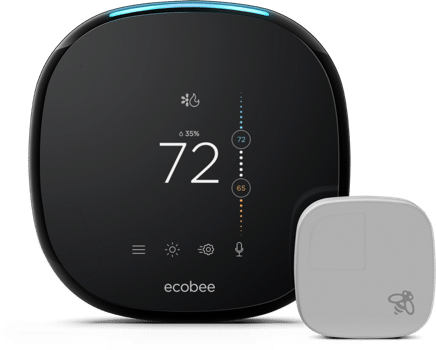
Where Should Your Home’s Thermostat Be Located?
When designing an HVAC system, there are a lot of minor details that can make a big difference in comfort and efficiency. One of those important details is the placement of the thermostat. The thermostat needs to be placed so that it can get the most accurate reading of the home’s air temperature. Otherwise, it can lead to your HVAC system running unnecessarily or not enough., This can decrease your comfort and potentially increase your energy bills.
See Also: Thermostats
Locations to Avoid
When placing a thermostat, you need to avoid locating it near things that can cause falsely high or low readings—in other words, away from localized hot spots or cold spots.
- Windows and doors: Don’t place your thermostat near windows or doors that may let in drafts. Your thermostat will be measuring the temperature of the outside air sneaking in. Instead of the overall indoor air temperature. Your thermostat will be affected by the fluctuation in temperature every time an exterior door is opened. This can cause your HVAC system to cut on and off unnecessarily. That’s inefficient, hard on the equipment, and leads to less stable temperatures in the home overall. It’s also important to make sure that your thermostat isn’t in direct sunlight coming through a window. If the sun is shining right on your thermostat, you could end up with a massive energy bill in the summertime.
- Exterior walls: Likewise, don’t place your thermostat on an exterior wall. The radiant temperature of that wall will be higher in summer and lower in winter than the air temperature inside your home. This can lead to your HVAC system running unnecessarily and driving up your bills.
- Supply vents: Placing a thermostat directly above or below a supply register can really confuse the system. That’s because the air blowing out of the vent will be significantly warmer or cooler than the overall temperature of your home, since it’s conditioned air that just came from the HVAC unit. This can cause major fluctuations in the temperature reading of the thermostat, again leading to the HVAC unit frequently turning on and off. And it will definitely make your home less comfortable!
- Hallways and other less-used areas: It’s very common for thermostats to be placed in hallways. Unfortunately, this is less than ideal. After all, you probably don’t spend a lot of time hanging out in the hallway of your house. Why would you want it to be the space that’s at the “perfect” temperature? Because hallways are generally long and narrow, they have decreased airflow and circulation. This means the hallway temperature often doesn’t reflect the average air temperature of the house as a whole. Placing your thermostat in the hallway means that the hall will be comfortable. The rest of your house may not be.
See Also: Update Your Thermostat to Save Money and Time
Consider Areas That are Naturally Warmer
- Bathrooms and kitchens: Steam and heat from the bathroom and kitchen can cause your thermostat to think it’s warmer than it actually is. In the summer, this can mean higher bills. In the winter, it could mean that you’re shivering in the living room because your kitchen is nice and warm from baking those Christmas cookies. Placing your thermostat in or near a bathroom or kitchen also causes a similar problem to placing it near a door. The temperature in those rooms tends to fluctuate a lot. It can cause your system to turn on and off too frequently. That’s not good for the lifespan of the equipment or your utility bills.
- Lamps and TV sets: The U.S. Department of Energy’s Energy Saver website recommends that you keep lamps and TV sets away from your thermostat. Lamps and televisions both put out a fair bit of heat. If they’re very close to your thermostat, they can actually cause your air conditioning to run too much in the summer
- Plumbing and supply ducts: Other sources of radiant heating or cooling that can throw off your thermostat are plumbing and supply ducts. Air or water running through pipes and ducts can heat or cool the walls around them. If your thermostat is on one of those walls, it won’t give an accurate reading for the air temperature of the room.
See Also: Ecobee vs. Nest
Where Your Thermostat Should Be
Now that you know what to avoid, let’s talk about where your thermostat should go. You want to place it on an interior wall that doesn’t have pipes or ducts running through it. It needs to be away from doors and windows, and out of direct sunlight.
See Also: Lower Your Energy Bill This Summer
You want to make sure that the thermostat isn’t directly above or below a supply register. It is actually fine (and some say preferable) for the thermostat to be located near a return intake.
For best results, you want the thermostat centrally located. This is a part of the home that you frequently use rather than tucked away in a hall. The thermostat should be positioned at a height of about 52-60 inches. Since heat rises, if the thermostat is higher than that, the readings will tend to be too warm.
Do you have a zoning system or a smart thermostat with multiple room sensors,? You can avoid some of the potential problems associated with having just one thermostat controlling the temperature of an entire house. It’s still important to remember to avoid things like direct sunlight, supply vents, and heat sources like television sets when placing those additional sensors or thermostats.


